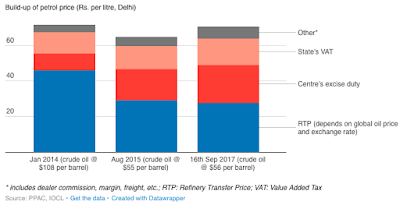I believe that people with ideological predilections are unlikely to be swayed by evidence. Therefore evidence of the failings of public private partnerships (PPPs) in delivering on outcomes and value for money, howsoever credible and compelling, is unlikely to shake the faith of those with the ideological belief that markets always work better than governments.
But when the evidence on failures of PPPs is carried, repeatedly at that, by the mouthpiece of free-market capitalism, Financial Times, it may be that the faith is getting unsettled.
The UK was among the leaders in the use of private capital to deliver public services through structured contracts. Apart from core-infrastructure like transportation and power plants, UK, though its Private Finance Initiative (PFI), pioneered the use of PPPs in social sectors like the construction and management of schools, hospitals, prisons and so on. At its peak, PFI projects formed 10-15% of the gross public sector investments.
But in a quite stunning reversal of fortunes, the number of PFI projects that achieved financial closure have nose-dived from over 70 in 2006 to zero in 2016!
Apart from fiscal squeeze and the financial crisis, the FT points to another, possibly the most critical, explanation for this decline,
Early PFI projects were shown to be poor value for money, giving equity investors windfall gains not commensurate with the risks they had taken.
Even though it has fallen off favour, its legacy is bitter and will remain so for another thirty years. It is estimated that the 716 contracted out projects, with capital value of about £60 bn, will cost the public exchequer about £10 bn a year, declining gradually till 2050. Education and health form two of the three biggest sectors covering these investments.
Econ 101 logic favours contracting out construction and operation & maintenance (O&M) to one party (or consortium) on the belief that it would align incentives and minimise life-cycle costs of the project. The construction would be of very high quality so as to keep the maintenance costs low. This may have been so when such PPPs were first tried out. The construction contractor then stayed on to operate and maintain the project.
But as the market expanded and matured, there emerged a neat segmentation between construction and O&M. The big construction firms assumed the construction risks, constructed and commissioned projects. Once construction risks were off-loaded and since the commissioned project would give a steady long-term revenue, they became attractive to a new category of entities, infrastructure funds. These funds leverage patient capital from pension funds, insurers, sovereign funds, and the like and assume control of a portfolio of projects, outsourcing the physical management to separate O&M contractors.
In simple terms, the asset's ownership becomes similar to a financial instrument, a tradeable instrument, moving from one infrastructure fund to another or to other financial intermediaries like private equity firms. All along the asset is managed by another entity as a service contract. As an example, again highlighted repeatedly by the FT, the consortium led by Macquarie which controlled London's water utility Thames Water for 11 years loaded up £10.6 bn in debt, ran up £260 m pension liabilities, made returns in the range of 15.9-19 per cent and exited with handsome profits. With even lower ownership tenures, allegations of asset stripping by way of loading up debt abound.
In simple terms, the asset's ownership becomes similar to a financial instrument, a tradeable instrument, moving from one infrastructure fund to another or to other financial intermediaries like private equity firms. All along the asset is managed by another entity as a service contract. As an example, again highlighted repeatedly by the FT, the consortium led by Macquarie which controlled London's water utility Thames Water for 11 years loaded up £10.6 bn in debt, ran up £260 m pension liabilities, made returns in the range of 15.9-19 per cent and exited with handsome profits. With even lower ownership tenures, allegations of asset stripping by way of loading up debt abound.
As an illustration, just a handful of infrastructure funds and other financial entities now own most of the UK PFI assets.
The original argument of incentive compatibility no longer applies with the prevailing model of PPP contracting.
This inherent incentive misalignment compounds the difficulty of writing good contracts in welfare and development sectors like education, healthcare, and prisons. As Oliver Hart, Andrei Shleifer, and Robert Vishny have shown, in sectors where quality is not easily contractible, private participation will struggle to deliver value for money. Worse still, there are also ample opportunities to cut costs either by skimping on maintenance or running down assets or cutting corners on quality (as the Thames Water fines for releasing untreated sewerage shows) or just laying off people and using contract labour and temps. So the investors have headroom of several years, maybe a couple of decades, to squeeze out massive profits by cutting costs and deferring investments.
Do we need more evidence to shake the ideological faith that PPPs are not the holy grail that they are made out to be? Among the ardent ideologues, such snake oil remedies continue to exercise their hold.
So, what is the way forward? A practical approach would be to discard the logic of Econ 101, view construction and O&M as two distinct activities, and leverage private capital only to finance O&M using contracts which are tightly regulated. Where service quality cannot be contracted credibly, avoid wholesale long-term concession and use shorter duration service contracts. But managing such contracts, in turn, require strong state capacity, an egregious deficiency in developing countries!














